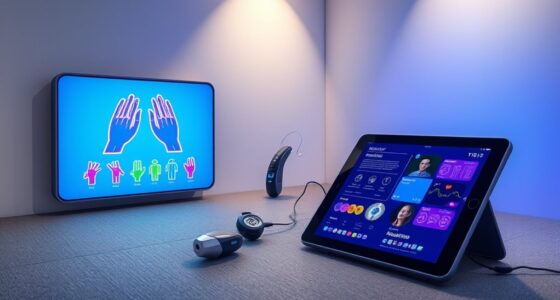Smartphones are transforming how you communicate as a deaf person by offering instant sign language translation, real-time captioning, and accessible video calls that remove traditional barriers. Apps and features like live captions, sign language recognition, and video messaging make conversations more seamless and inclusive. They also let you connect in communities and share stories easily. If you want to discover how these advancements are shaping everyday interactions, there’s more to explore below.
Key Takeaways
- Smartphones enable real-time sign language translation and captioning, improving instant communication for deaf users.
- Video calling features support natural, face-to-face sign language conversations across distances.
- Accessibility apps and AI tools automate translation, making information more accessible and fostering independence.
- Instant messaging and live transcription enhance communication in noisy environments and where sign language interpreters are unavailable.
- Social media and community platforms facilitate sharing, awareness, and advocacy, strengthening connections within the deaf community.
The Rise of Mobile Accessibility Features for Deaf Users

The rise of mobile accessibility features has revolutionized communication for deaf users by making smartphones more inclusive. These features, like real-time captioning and sign language translation, enable seamless conversations without relying on audio.
Apps such as Ava, RogerVoice, and Hand Talk provide instant sign language translation and speech-to-text services, bridging communication gaps.
Video calling functions now support sign language communication in real time, allowing you to connect effortlessly with others from afar.
Built-in features like vibration alerts and visual notifications ensure you stay informed without needing sound.
Thanks to AI-powered tools and dedicated accessibility settings, smartphones are becoming powerful tools that foster independence, improve connectivity, and make daily interactions more accessible for deaf communities worldwide.
Real-Time Texting and Instant Messaging Transform Communication

Real-time text messaging has revolutionized how deaf users communicate by providing immediate and spontaneous conversations without relying on relay services. With apps like WhatsApp, Messenger, and Signal, you can engage in instant messaging that offers direct and on-the-spot communication. Features like live captions and instant typing feedback make interactions smoother and more natural, mimicking face-to-face conversations. This shift from traditional relay calls gives you greater control and independence in your communication. The widespread adoption of instant messaging has considerably increased your social connectivity and participation within deaf communities worldwide. Mandatory waiting period and other legal requirements in divorce processes highlight the importance of understanding formal procedures to ensure successful communication and resolution. Additionally, communication technology continues to evolve, further enhancing the ways deaf individuals can connect seamlessly in various settings, especially as new communication tools are developed to support diverse needs. The integration of essential oils in communication environments can also promote a calming atmosphere, reducing stress during discussions or negotiations. Furthermore, AI-powered content clustering helps organizations tailor and optimize communication strategies for deaf users, ensuring more effective outreach and engagement.
Video Calling and Sign Language Integration
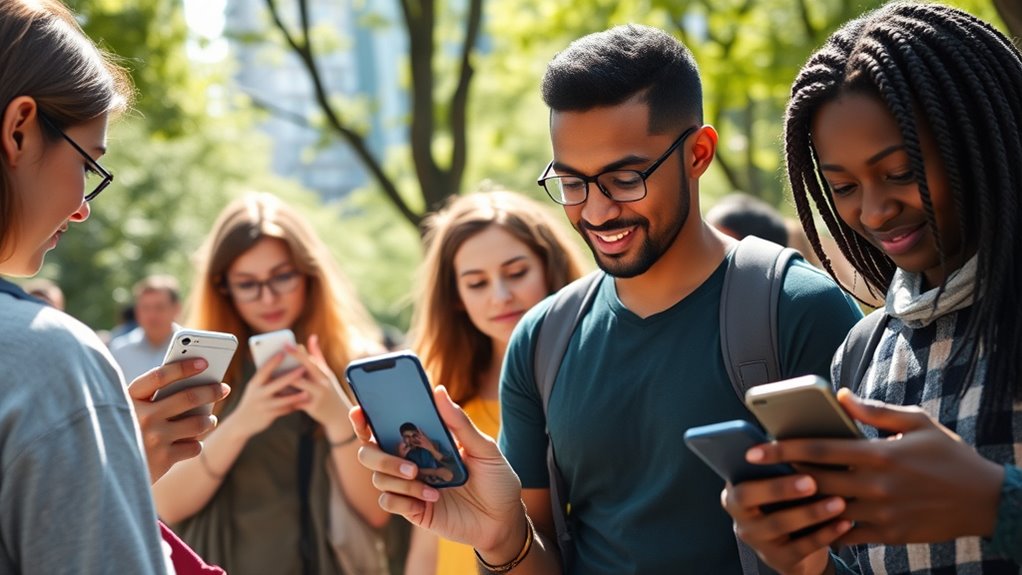
Smartphones now make sign language video platforms more accessible, allowing you to communicate directly through high-quality video calls. These tools offer real-time interactions that improve understanding and reduce delays. Additionally, cozy living environments can be enhanced by integrating smart home devices that facilitate easier communication and support for deaf users. The widespread availability of video calling technology also fosters greater social inclusion, enabling deaf individuals to maintain personal and professional relationships more easily. As a result, deaf users gain greater independence and connect more easily with others worldwide. Furthermore, understanding ear wax odor can be important for health awareness, as changes in smell may signal infections or other issues. Incorporating assistive communication tools into daily routines can further empower deaf individuals to navigate various social and professional settings with confidence. Advances in assistive technology continue to expand opportunities for meaningful interaction and participation in society.
Sign Language Video Platforms
Video calling platforms like FaceTime, WhatsApp, and Zoom have revolutionized how deaf individuals communicate by allowing sign language to be used seamlessly in real time. These platforms now integrate sign language interpretation features or let you share gestures directly during calls, making communication more natural. These technological improvements facilitate more inclusive communication for deaf users. High-quality webcams and stable internet improve clarity and fluidity, enhancing expressiveness. These advancements also contribute to communication accessibility, ensuring that deaf individuals can participate fully in social, educational, and professional contexts. Additionally, video quality improvements have played a significant role in making these interactions more effective and accessible, especially as bandwidth capabilities continue to expand globally. Moreover, the availability of specialized sign language video platforms tailored for deaf users further enhances the ease and effectiveness of visual communication.
Real-Time Communication Benefits
Sign language video platforms have markedly improved how deaf individuals connect visually, but the ability to communicate instantly through live calls takes it a step further. With video calls, you can:
- Use sign language effortlessly in real-time, reducing communication delays.
- Benefit from real-time sign language interpretation, making conversations more natural.
- Access live captioning features that translate spoken words, enhancing understanding.
- Leverage sign language recognition technology for automated translation, increasing accessibility.
Sign language recognition technology continues to advance, offering more accurate and reliable communication tools for users.
These tools, combined with high-quality webcams and stable internet, guarantee your sign language communication is clear and immediate.
The integration of real-time communication in smartphones creates a seamless, more natural experience, breaking down barriers and fostering better connections within the deaf community.
Accessibility Enhancements
Thanks to integrated features like sign language interpretation and real-time captioning, you can now communicate more effectively during calls. Video calling apps like FaceTime, WhatsApp, and Zoom enable seamless sign language exchanges with high-quality webcams and front-facing cameras that provide clear, lag-free visuals.
Assistive technologies in smartphones translate spoken language into sign language, making conversations more accessible. Features such as sign language interpretation help bridge communication gaps, while real-time captioning and speech-to-text tools support those who prefer written communication.
Mobile platforms increasingly support sign language recognition technology, automatically translating gestures into text or speech during calls. These accessibility enhancements ensure that deaf users can participate fully in conversations, breaking down barriers and fostering more inclusive communication.
Sign Language Apps and Translation Tools
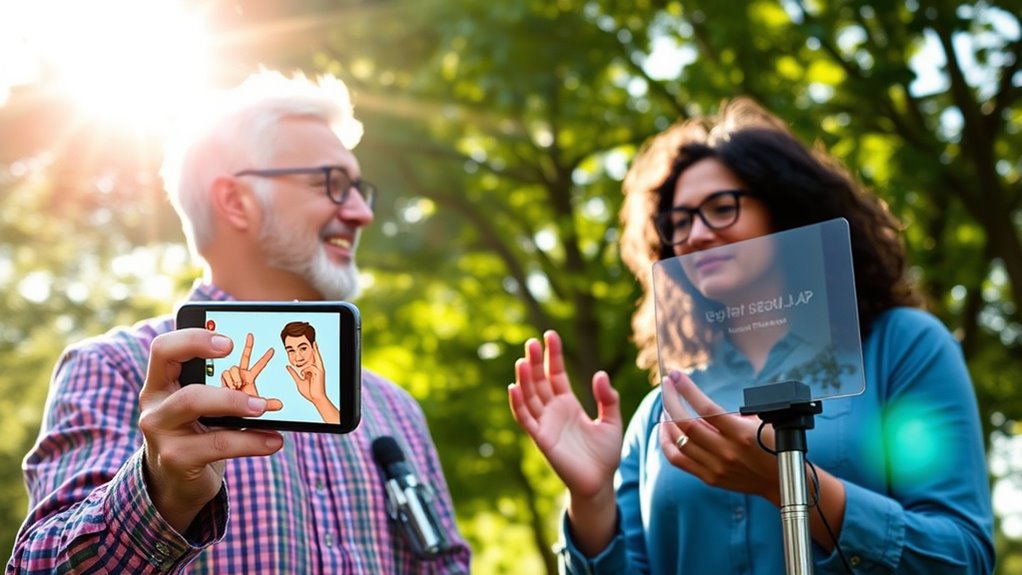
Smartphone technology has revolutionized how deaf individuals communicate by providing innovative sign language apps and translation tools. These tools make information more accessible and streamline conversations. For example:
- Sign language apps like Hand Talk and SignAll use AI to animate signs from text, improving understanding.
- Translation tools enable real-time sign language interpretation during chats, reducing barriers.
- Sign language dictionaries with video demonstrations help you learn and practice signs independently.
- Advances in gesture recognition allow smartphones to interpret and respond to sign gestures naturally. Accessible communication features foster greater independence for deaf users.
Furthermore, the development of assistive technology continues to enhance communication options, making interactions more seamless. These features promote inclusion by making communication with hearing people easier and more intuitive. Additionally, business opportunities in this technology sector are expanding as demand for accessible communication tools grows.
Captioning and Speech-to-Text Technologies Enhancing Understanding
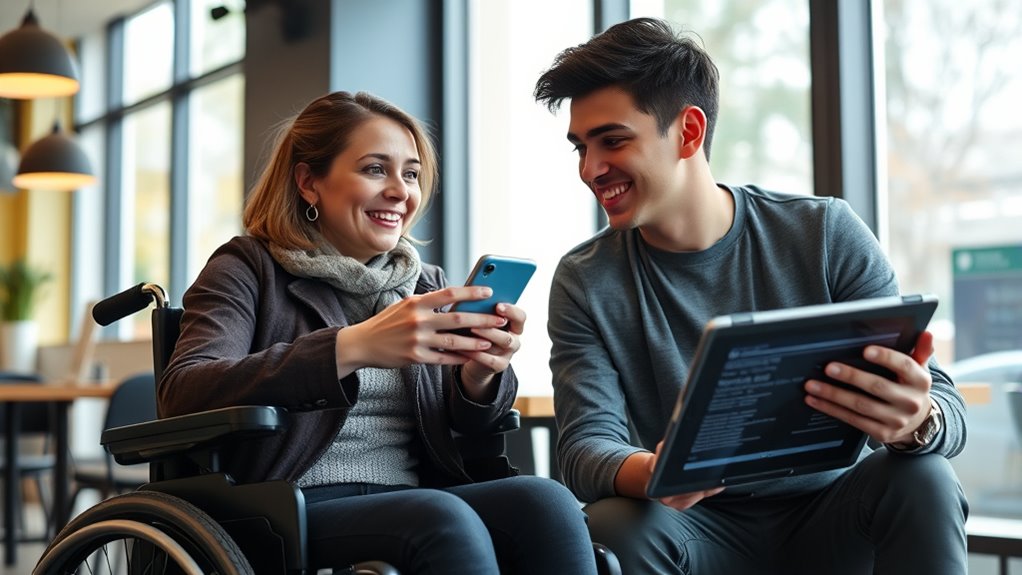
You can now use your smartphone’s speech-to-text features to get real-time captions during conversations, making communication clearer and more accessible. Apps like Otter.ai and Google Live Transcribe instantly convert speech into text, helping you understand in various settings. These tools break down barriers, giving you greater independence and easier access to learning and social interactions. Enhancing communication through technology can significantly improve the quality of interactions for deaf individuals.
Real-Time Captioning Benefits
Real-time captioning has revolutionized how deaf individuals engage in conversations by providing instant text transcriptions of spoken words. This assistive technology enhances communication accessibility, making interactions smoother and more inclusive. With advanced captioning apps and devices, you experience near-perfect accuracy, reducing misunderstandings in live settings. Additionally, American diner classics like eggs Benedict and pancakes with maple syrup showcase how traditional comfort foods continue to bring people together, much like effective communication methods foster connection. During video calls, real-time captioning offers immediate text display of speech, bridging gaps in remote communication. Additionally, AI-powered tools allow for automatic translation across multiple languages, expanding your global communication opportunities. These innovations often incorporate holistic approaches that consider the diverse needs of users, further improving overall effectiveness. Incorporating user-centered design principles ensures these captioning solutions remain accessible and user-friendly for all individuals. Moreover, understanding the diversity of communication styles helps developers create more adaptable and inclusive captioning systems. Overall, real-time captioning benefits include:
- Improved comprehension during conversations
- Increased independence in social and professional settings
- Enhanced participation in educational activities
- Broader access to diverse communication channels
This technology empowers you to connect more confidently and independently in everyday life.
Accessibility and Learning Tools
How do captioning and speech-to-text technologies enhance understanding for deaf individuals? These tools provide real-time transcriptions of spoken language, boosting accessibility during conversations, meetings, or lectures.
Advanced algorithms in apps like live captioning and voice recognition ensure accurate, immediate conversion of speech to text, supporting both casual chats and professional interactions.
They help you understand in noisy environments or when sign language interpretation isn’t available, increasing your independence.
Integration of captioning features into messaging and video call platforms makes digital communication more inclusive.
As AI-driven speech-to-text tools continue to improve, the speed and accuracy of capturing spoken content get better, fostering seamless learning and social experiences.
These innovations make communication clearer and more accessible than ever before.
Social Media Platforms as Virtual Deaf Communities
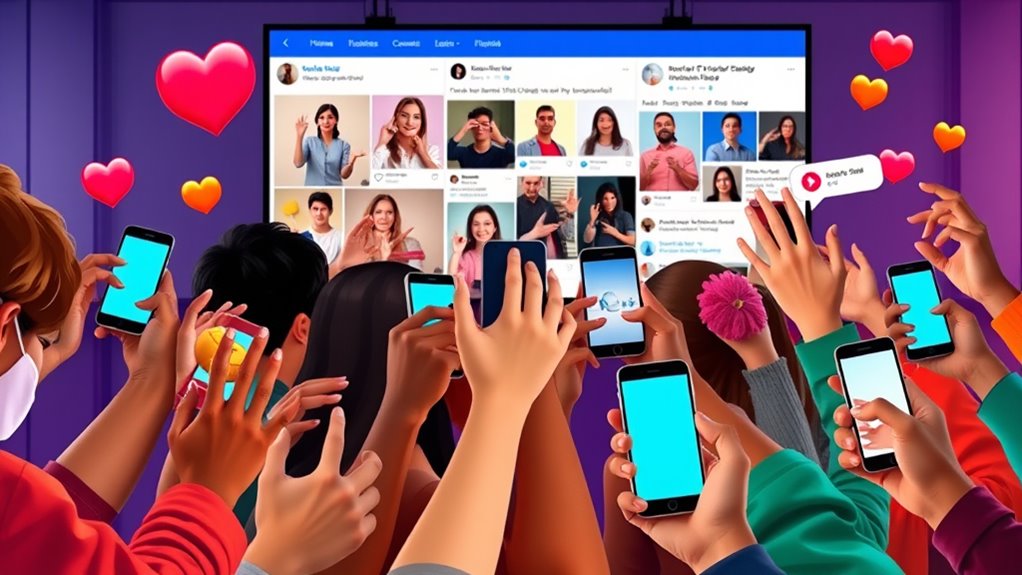
Social media platforms like Facebook, Instagram, and Twitter have become essential spaces for deaf users to build and engage in virtual communities centered around deaf culture, language, and shared experiences. These platforms enable you to:
- Share stories, news, and resources quickly, strengthening bonds within the deaf community worldwide.
- Use video features like live streaming and video chats to communicate in sign language, making interactions authentic and accessible.
- Foster awareness and advocacy, empowering members to challenge stereotypes and promote inclusivity.
- Participate actively in deaf-specific groups and pages, often with higher engagement compared to general audiences.
Overcoming Barriers: Smartphone Use in Low-Income and Remote Areas
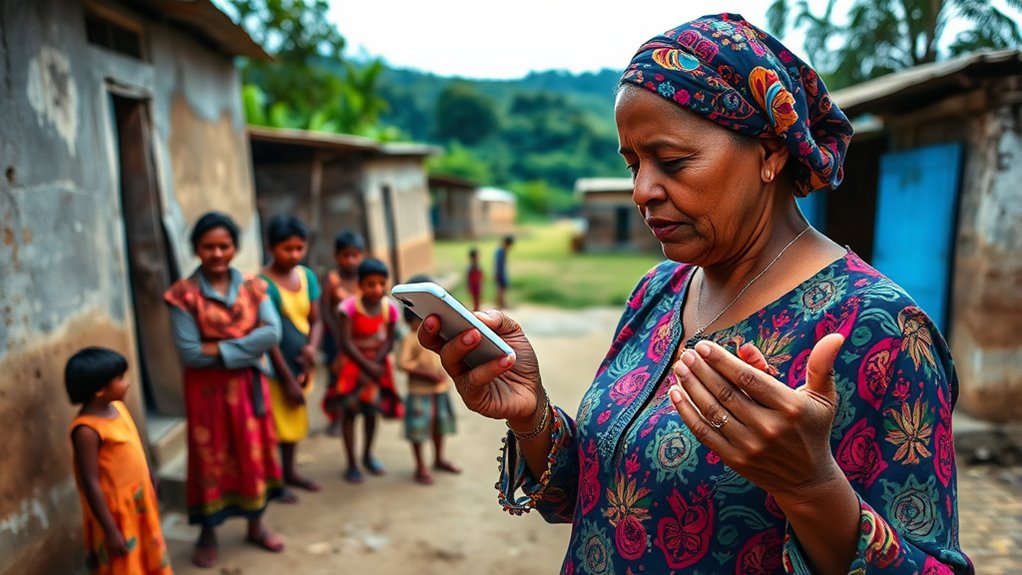
Despite the significant benefits smartphones offer for deaf communication, many individuals in low-income and remote areas face substantial barriers to accessing these technologies. Limited internet access and the high cost of smartphones restrict your ability to use essential apps like captioning and sign language tools. Socioeconomic disparities often mean relying on outdated or less accessible devices, making real-time communication difficult. Without reliable internet, features such as live video relay or instant messaging become nearly impossible to use consistently. To overcome these barriers, efforts focus on providing affordable devices, expanding network coverage, and distributing assistive technology. These initiatives aim to bridge gaps, ensuring that even in underserved regions, deaf individuals can harness the power of smartphones for effective communication.
| Barrier | Solution |
|---|---|
| High device costs | Affordable devices and subsidy programs |
| Limited internet access | Expanded network coverage and infrastructure |
| Outdated technology | Distribution of modern assistive technology |
| Unreliable connectivity | Improved infrastructure for consistent access |
| Socioeconomic barriers | Targeted programs supporting underserved communities |
Challenges and Opportunities in Smartphone Accessibility Development

Advancements in smartphone technology present both significant opportunities and notable challenges for improving accessibility for deaf users. Socioeconomic disparities still limit smartphone accessibility, especially in low-income communities.
To maximize benefits, developers must focus on:
- Creating affordable, effective assistive devices that enhance communication.
- Developing sign language translation apps that deliver real-time, accurate interpretation.
- Increasing awareness and training among hearing populations to better utilize accessible features.
- Ensuring technology complements traditional sign language preservation efforts rather than replacing them.
While ongoing innovation offers promising solutions, consistent funding and inclusive design are essential.
Overcoming these challenges can access the full potential of smartphone accessibility, empowering deaf users to communicate more effectively and independently.
Future Trends: AI, 5G, and Emerging Communication Technologies
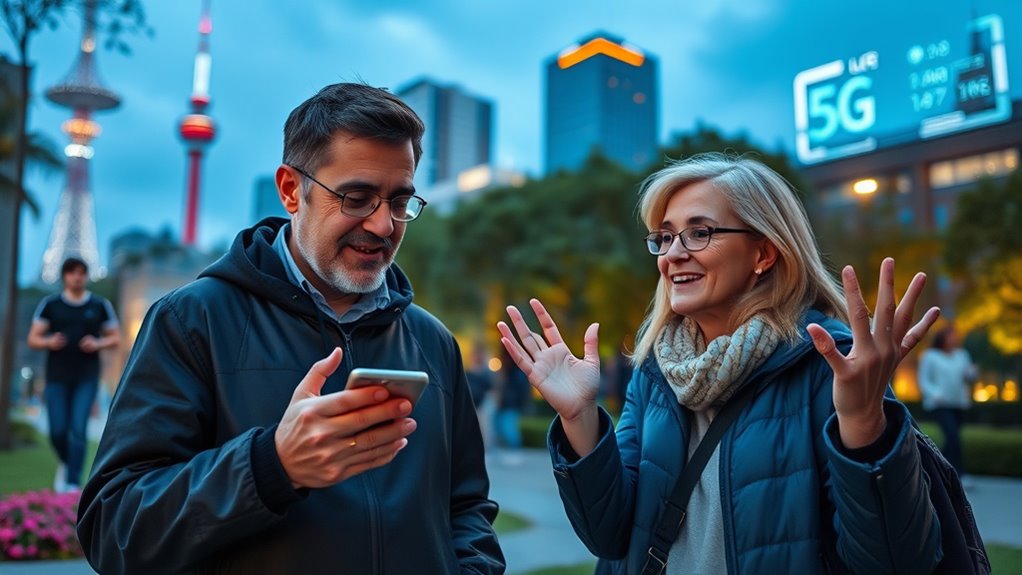
Emerging communication technologies powered by AI and 5G are set to revolutionize how deaf users connect and interact. With 5G’s ultra-fast, low-latency connections, real-time sign language interpretation and video chats become seamless. Advances in AI enable instant sign language recognition and translation, making conversations more accurate. These innovations support immersive virtual and augmented reality experiences, enhancing remote social and educational interactions. Additionally, AI-driven predictive text and captioning tools improve accessibility in noisy environments. Future developments include 5G-enabled smart devices and AI assistants that proactively support deaf users with contextual cues, alerts, and personalized sign language content. Imagine the possibilities:
| Technology | Impact |
|---|---|
| 5G | Faster, real-time communication |
| Artificial Intelligence | Instant translation and predictive tools |
| Emerging Platforms | Immersive social and educational experiences |
Frequently Asked Questions
How Have Smartphones Changed Communication?
You’ll find that smartphones transform how you communicate by making it faster and more direct. Instead of relying on TTYs or relay services, you can send instant texts or make video calls.
Apps with sign language and real-time captioning help you connect smoothly across different situations. Plus, social media and online communities let you share stories and resources, boosting your independence, social life, and participation in both personal and professional spheres.
How Do Deaf People Communicate Over the Phone?
You might wonder how deaf people communicate over the phone. They use a variety of methods, including video relay services (VRS), which let them sign in real-time via video calls.
Smartphone apps like FaceTime or WhatsApp make it easy to connect visually. Text messaging and captioning apps also help, providing instant written communication.
Relay services act as middlemen, ensuring smooth conversations between deaf users and hearing individuals.
How Technology Has Changed the Deaf Culture?
Imagine deaf culture as a vibrant river flowing freely. Technology acts like a mighty dam, shaping its course.
With smartphones, you’ve gained new channels to share stories, connect instantly, and showcase your identity. Social media, captioning, and sign apps are like bridges, bringing your community closer.
This digital transformation preserves your culture and amplifies your voice, ensuring your traditions and messages reach far beyond what once seemed possible.
How Do Most Deaf People Currently Use the Phone at Home?
Most deaf people at home use their smartphones mainly for text messaging and video calls, skipping traditional voice calls. They rely on video relay services (VRS) to connect with hearing people through interpreters during calls.
Captioned phone apps offer real-time transcriptions, making conversations easier. Instant messaging and social media are popular for quick chats with friends and family.
While traditional voice calls are less common, dedicated sign language apps and video chats are key tools for communication.
Conclusion
So, here you are, thinking smartphones are just for selfies and memes, but they’re actually revolutionizing deaf communication. It’s funny how a device many take for granted now bridges gaps that once seemed endless. Sure, there are hurdles, but with AI, 5G, and endless apps, it’s clear that your phone might just become the best interpreter you’ve ever had—who knew that tiny screen could change the world?







